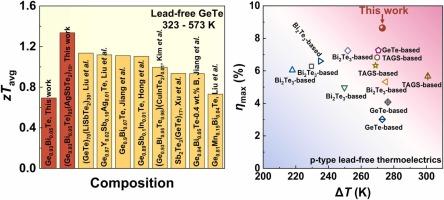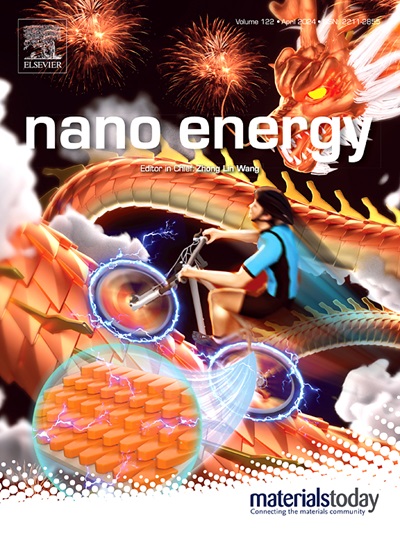低品位废热收集用高热电性能无铅GeTe合金
IF 16.8
1区 材料科学
Q1 CHEMISTRY, PHYSICAL
引用次数: 0
摘要
近年来,工业低品位废热的收集和利用引起了人们的极大关注。热电材料可以直接将热量转化为电能,为废热回收提供了环保的解决方案。最近,gete基材料已经发展成为Bi2Te3在室温附近的有力竞争对手。然而,尽管表现出相当的热电性能,但这些GeTe合金中的大多数都含有有毒的Pb,从而限制了实际应用。通过引入Ge缺陷,在Ge0.93Bi0.05Te中实现了整个温度范围内zT的提升。进一步的AgSbTe2合金化导致了态密度有效质量的显著增加和高加权迁移率。在热力学上,AgSbTe2的加入形成了各种声子散射中心,包括畴结构、位错和相边界,有助于降低晶格导热系数。结果表明,无铅(Ge0.93Bi0.05Te)85(AgSbTe2)15材料的平均zT为1.34 (323-573 K),在ΔT = 273 K时单支转换效率最高,达到8.6%。优异的热电性能和无铅特性显示了GeTe合金在回收低品位废热方面的应用潜力。本文章由计算机程序翻译,如有差异,请以英文原文为准。

Lead-free GeTe alloys with high thermoelectric performance for low-grade waste heat energy harvesting
Harvesting and utilization of low-grade waste heat dissipated from industries have garnered immense attention in recent years. Thermoelectric materials, which can directly convert heat into electricity, provide an eco-friendly solution for waste heat recovery. Recently, GeTe-based materials have developed as strong competitors to Bi2Te3 near room temperature. Nonetheless, despite exhibiting comparable thermoelectric performance, the majority of these GeTe alloys incorporate toxic Pb, thus limiting the practical application. Herein, a boosted zT was achieved in Ge0.93Bi0.05Te over the entire temperature range by introducing Ge deficiency. Further AgSbTe2 alloying leads to a remarkable increase in density-of-states effective mass and high weighted mobility. Thermally, the addition of AgSbTe2 forms various phonon scattering centers including domain structures, dislocations, and phase boundaries, contributing to the low lattice thermal conductivity. As a result, a high average zT of 1.34 (323–573 K) is obtained in the lead-free (Ge0.93Bi0.05Te)85(AgSbTe2)15 material, and its maximum single-leg conversion efficiency reaches 8.6 % at T = 273 K. The outstanding thermoelectric performance and the lead-free characteristic presented in our study shed light on the potential of GeTe alloys for applications in recovering low-grade waste heat.
求助全文
通过发布文献求助,成功后即可免费获取论文全文。
去求助
来源期刊

Nano Energy
CHEMISTRY, PHYSICAL-NANOSCIENCE & NANOTECHNOLOGY
CiteScore
30.30
自引率
7.40%
发文量
1207
审稿时长
23 days
期刊介绍:
Nano Energy is a multidisciplinary, rapid-publication forum of original peer-reviewed contributions on the science and engineering of nanomaterials and nanodevices used in all forms of energy harvesting, conversion, storage, utilization and policy. Through its mixture of articles, reviews, communications, research news, and information on key developments, Nano Energy provides a comprehensive coverage of this exciting and dynamic field which joins nanoscience and nanotechnology with energy science. The journal is relevant to all those who are interested in nanomaterials solutions to the energy problem.
Nano Energy publishes original experimental and theoretical research on all aspects of energy-related research which utilizes nanomaterials and nanotechnology. Manuscripts of four types are considered: review articles which inform readers of the latest research and advances in energy science; rapid communications which feature exciting research breakthroughs in the field; full-length articles which report comprehensive research developments; and news and opinions which comment on topical issues or express views on the developments in related fields.
 求助内容:
求助内容: 应助结果提醒方式:
应助结果提醒方式:


